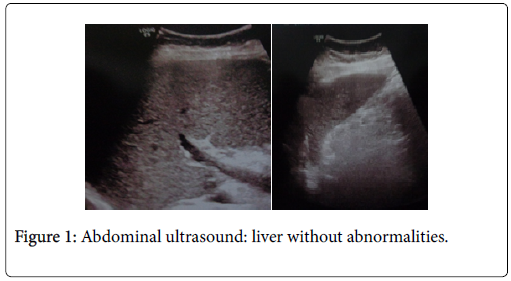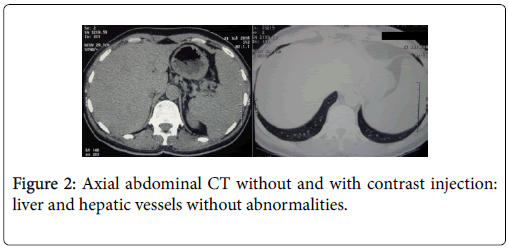Fulminant Hepatitis Induced by Valproic Acid: An Exceptional Iatrogenic Accident in Adults
Received: 29-Jan-2019 / Accepted Date: 05-Mar-2019 / Published Date: 15-Mar-2019 DOI: 10.4172/2161-069X.1000593
Abstract
Introduction: Fulminant hepatitis induced by Valproic Acid (VPA) occurs especially in children under two years of age, polypathological, polymedicated, and often with inborn errors of metabolism and mental retardation. It remains an exceptional iatrogenic accident in healthy adults with a prevalence not exceeding 0.01 to 0.02%, and usually fatal.
We are reporting an original observation of spontaneously resolved VPA-induced fulminant hepatitis in competent healthy adult.
Case report: A 24-year-old woman treated with VPA (Depakine chrono®500 mg, 1200 mg/day) for three weeks because of epilepsy was hospitalized for jaundice, vomiting, and alteration of her general condition that had been evolving for two days. Clinical examination noted a patient with fever at 38°C, cutaneous and mucous jaundice, tremor flapping, temporospatial disorientation, and Glascow Coma Score at 14/15. The biology showed: ASAT at 1865 IU/l, ALAT at 1986 IU/l, TB at 253 μmol/l, DB at 152 μmol/l, and PT at 45%. Factor V was at 38% and the rest of the basic bioassays were within normal limits.
Further investigations were negative. The diagnosis of VPA-induced fulminant hepatitis with acute hepatic failure and hepatic encephalopathy was retained. After discontinuation of the culprit drug and intensive resuscitation the evolution was favorable. All liver tests were strictly normal after one month.
Conclusion: VPA-induced fulminant hepatitis should be known and systematically evoked in front of any unexplained symptom in patient treated with this anticonvulsant drug. Only early diagnosis makes it possible to envisage rapid and adapted management, and thus improve the spontaneously fatal prognosis of these iatrogenic accidents.
Keywords: Fulminant hepatitis; Valproic acid; Drug toxicity; Iatrogenesis
Abbreviations
ASAT: Aspartate Aminotransferase; ALAT: Alanine Aminotransferase; Anti-LKM1: Anti-Liver Kidney Microsome Type 1 Antibodies; Anti-M2: Anti-Mitochondrial M2 Antibodies; CMV: Cytomegalovirus; CPK: Creatine Phosphokinase; EBV: Epstein-Barr Virus; ϓGT: Gamma-Glutamyltransferase; HIV: Human Immunodeficiency Virus; LDH: Lactate Dehydrogenase, ALP: Alkaline Phosphatase; PT: Prothrombin Time.
Introduction
Hepatic toxicity, especially in severe forms, represents a real diagnostic challenge for clinicians and must always remain a diagnosis of elimination [1]. The drugs most often involved are acetaminophen, antibiotics, anti-tuberculous therapy, and anticonvulsants [1,2]. The most severe clinical presentation of this iatrogenic hepatopathy is acute hepatic failure (defined as a factor V less than 50%) by acute cytotoxic hepatitis [1,2]. It is characterized by a mortality of 10 to 20% [2].
Valproic acid (VPA), anticonvulsant and mood-stabilizing drug widely used in both children and adults is only exceptionally found as a cause of this toxic hepatitis: prevalence estimated at less than 1/1000 cases [2-5]. This hepatitis is severe, often fatal, and exceptionally reversible [5]. They occur especially in children, particularly those under two years of age, who are polypathological, polymedicated, and often with inborn errors of metabolism and mental retardation [3,6-8]. These hepatitis remain exceptional in adults [3,6]. Indeed, in the review of Scott et al. and among the 100 cases of VPA-induced acute hepatitis, only seven occurred in adults while the majority occurred in children under ten years of age [7].
Fulminant hepatitis (defined according to the French classification by the presence of encephalopathy in the first two weeks [1]) induced by VPA are usually fatal [9,10]. We are reporting an original observation of spontaneously resolved fulminant hepatitis induced by VPA in competent healthy adult.
Case Report
A 24-year-old woman was explored for recurrent generalized tonicclonic seizures at the age of 20, whose specific investigations led to the diagnosis of epilepsy. She was initially treated with carbamazepine, then phenobarbital, and then clobazam but without a complete response. Treatment with valproic acid (Depakine chrono®500 mg, 1200 mg/day) had been prescribed for three weeks.
She was hospitalized for frank mucocutaneous jaundice associated with vomiting and an alteration of her general condition that had been evolving for two days.
Clinical examination noted a patient with fever at 38°C, cutaneous and mucous jaundice, tremor flapping, temporospatial disorientation, and initial Glascow coma score at 14/15 (best eye response: open spontaneously (4), best verbal response: confused (4), and best motor response: obeys commands (6). The hemodynamic and respiratory states were stable, and there were no skin lesions, lymphadenopathies, palpable tumors or visceromegalies.
The biology showed severe cytolytic hepatitis with cholestasis and hepatocellular insufficiency: ASAT at 1865 IU/l, ALAT at 1986 IU/l, TB at 253 μmol/l, DB at 152 μmol/l, and PT at 45%. Factor V was at 38%. The rest of the basic bioassays were within normal limits (leukocytes, hemoglobin, platelets, erythrocyte sedimentation rate, Creactive protein, serum calcium, phosphoremia, ionogram, blood glucose, creatinine, CPK, LDH, ALP, total cholesterol, triglycerides, serum protein electrophoresis, fT4, TSH, and urine analysis), as well as the electrocardiogram and chest X-ray.
Abdominal ultrasound and Computed Tomography (CT) showed no abnormalities, especially of liver and hepatic vessels (Figures 1 and 2).
The diagnosis of fulminant hepatitis with acute hepatic failure and hepatic encephalopathy was retained. The patient was transferred to the intensive care unit and supportive treatment was initiated.
The subsequent etiological investigations were negative, eliminating in particular viral hepatitis, autoimmune hepatitis, severe sepsis, systemic and autoimmune diseases and haemophagocytosis: blood and urine cultures, cardiac ultrasonography, serologies (hepatitis A, B, C, and E, CMV, HIV, EBV and Leptospirosis), Doppler examination of intra-abdominal vessels, gastrointestinal fibroscopy, cerebral CT-scan and lumbar puncture, tuberculous tests, anti-nuclear antibodies, antisoluble nuclear antigens antibodies, anti-neutrophil cytoplasm antibodies, anti-phospholipids antibodies, anticoagulant lupus, anti- LKM1, anti-smooth muscle antibodies, anti-M2, cryoglobulins, and myelogram.
Considering the negativity of the infectious, immunological, and tumoral investigations as well as the normality of the hepatic imaging, the diagnosis of toxic hepatitis induced by the VPA was evoked. This diagnostic hypothesis was confirmed by the specialized pharmacovigilance survey. After discontinuation of the drug in question and intensive resuscitation the evolution was favorable. All liver tests were strictly normal after one month.
Discussion
VPA-induced hepatotoxicity typically occurs in case of accidental or intentional overdose or supratherapeutic doses, but can sometimes occur even at usual therapeutic doses, particularly in chronic users, who sign an idiosyncratic reaction. Acute fulminant hepatitis is an exceptional iatrogenic accident in healthy adults [11,12] with a prevalence not exceeding 0.01 to 0.02% [8,13,14].
The pathophysiology of these hepatitis has not yet been fully elucidated [5,15]. Two main hypotheses are evoked:
• An idiosyncratic reaction with production of toxic VPA metabolites [5,16], especially delta 4-VPA, which is more toxic than the parent drug [8],
• Direct alteration of liver biochemical systems by VPA, with especially mitochondrial toxicity [5,8].
This hepatitis induced by VPA was long considered purely toxic (direct and/or idiosyncratic) without any immunological basis [9] but this hypothesis is no longer validated. Indeed, the first observation of VPA-induced fulminant hepatitis with clinical and histological stigmata of hypersensitivity allergic reaction was reported in 1986 by Colletti et al. [9], and then several other observations have been reported defining the new entity of "anticonvulsant hypersensitivity syndrome" caused by sodium valproate [10].
In this nosological entity, fulminant hepatitis is often associated with other cutaneous and/or visceral allergic reactions: lichinoid dermatitis, maculopapular eruption, coagulopathy, agranulocytosis, neutropenia, eosinophilia, lymphocytosis, lymphadenopathy, and cardiac involvement [4,10,17,18].
Oxidative stress is also currently recognized as a plausible factor strongly implicated in the genesis of this VPA-induced hepatotoxicity [16].
Clinically, this VPA-induced hepatotoxicity should be suspected in any patient treated with VPA at the onset of the following symptoms: lethargy, vomiting, and anorexia, otherwise the progression will be rapid to worsening and deep coma [5]. The authors distinguish three possible clinical syndromes as presentations of VPA-induced hepatotoxicity: chronic toxicity leading to progressive liver failure with encephalopathy, hyperammonemia with other minimal hepatic injuries, and Reye-like syndrome with rapid progression and often fatal evolution [8].
This VPA-induced fulminant hepatitis may remain isolated or associated with other direct visceral toxicities of the drug, often also fatal: pancreatic, cardiac, and renal [4,19,20].
Treatment consists of discontinuing the offending drug, providing supportive care, and in some cases (especially if anticonvulsant hypersensitivity syndrome) systemic corticosteroids [5,8,16-20].
Conclusion
As rare as it is, fulminant hepatitis caused by VPA should be known and systematically evoked in front of any unexplained symptom in patient treated with this anticonvulsant drug.
It is recommended that clinically, VPA-induced hepatotoxicity should be suspected at the onset of the following symptoms: lethargy, vomiting, and anorexia, otherwise the progression will be rapid to worsening and deep coma.
Only early diagnosis makes it possible to envisage rapid and adapted management, and thus improve the spontaneously fatal prognosis of these iatrogenic accidents.
References
- Amathieu R, Levesque E, Merle JC, Chemit M, Costentin C, et al. (2013) Severe toxic acute liver failure: Etiology and treatment. Ann Fr Anesth Reanim 32: 416-421.
- Ferrey G, Sicot C (1985) Clinical and physiopathologic study of the hepatotoxicity of psychotropic drugs including the antiepileptics. Encephale 11: 135-144.
- Zhu MM, Li HL, Shi LH, Chen XP, Luo J, et al. (2017) The pharmacogenomics of valproic acid. J Hum Genet 62: 1009-1014.
- Muñiz AE (2017) Valproic acid overdose review of a case with electrocardiographic changes. J Emerg Med 53: 333-338.
- Stephens JR, Levy RH (1992) Valproate hepatotoxicity syndrome: Hypotheses of pathogenesis. Pharm Weekbl Sci 14: 118-121.
- Galdames D, Silva C, Aguilera L, Chesta J (1993) Hepatotoxicity induced by valproic acid in adults. Report of 3 cases. Rev Med Chil 121: 1432-1436.
- Scott DA, Gholson CF, Netchvolodoff CV, Ray M, Gonzalez E, et al.(1991) Incidental microvesicular steatosis due to valproic acid anticonvulsant therapy. Am J Gastroenterol. 86: 500-502.
- Nanau RM, Neuman MG (2013) Adverse drug reactions induced by valproic acid. Clin Biochem 46: 1323-1338.
- Colletti RB, Trainer TD, Krawisz BR (1986). Reversible valproate fulminant hepatic failure. J Pediatr Gastroenterol Nutr 5: 990-994.
- Huang YL, Hong HS, Wang ZW, Kuo TT (2003) Fatal sodium valproate-induced hypersensitivity syndrome with lichenoid dermatitis and fulminant hepatitis. J Am Acad Dermatol. 49: 316-319.
- Bauer MS (2005) Fatal hepatic failure and valproate. Am J Psychiatry 162: 192.
- König SA, Schenk M, Sick C, Holm E, Heubner C, et al. (1999) Fatal liver failure associated with valproate therapy in a patient with Friedreich's disease: review of valproate hepatotoxicity in adults. Epilepsia 40: 1036-1040.
- Binek J, Hany A, Egloff B, Heer M (1991) Acute fatal liver insufficiency due to valproic acid therapy. Schweiz Med Wochenschr 121: 228-233.
- Schmid MM, Connemann BJ, Wolf RC, Flechtenmacher C, Eisenbach C, et al. (2010) Can we prevent fatal liver failure under valproate? Pharmacopsychiatry 43: 198-200.
- Chang TK, Abbott FS (2006) Oxidative stress as a mechanism of valproic acid-associated hepatotoxicity. Drug Metab Rev 38: 627-39.
- Chaudrey KH, Naser TB, Steinberg A, Avashia KD, Nouri-Kolouri M, et al.(2012) Thinking beyond the obvious: hepatotoxicity secondary to idiosyncratic depakote toxicity. Am J Ther 19: 403-406.
- Choi TS, Doh KS, Kim SH, Jang MS, Suh KS, et al. (2003) Clinicopathological and genotypic aspects of anticonvulsant-induced pseudolymphoma syndrome. Br J Dermatol. 148: 730-736.
- Conilleau V, Dompmartin A, Verneuil L, Michel M, Leroy D (1999). Hypersensitivity syndrome due to 2 anticonvulsant drugs. Contact Dermatitis. 41: 141-144.
- Bouget J, Deugnier Y, Camus C, Thoreux PH, Letulzo Y, et al. (1990) Valproic acid: Association of a fatal acute hepatitis and pancreatitis. Ann Med Interne (Paris) 141: 491-493.
- Yaman A, Kendirli T, Odek C, BektaÅŸ O, KuloÄŸlu Z, KoloÄŸlu M, et al. (2013) Valproic acid-induced acute pancreatitis and multiorgan failure in a child. Pediatr Emerg Care 29: 659-661.
Citation: Bouomrani S, Regaïeg N, Guermazi M, Belgacem N, Yahyaoui S (2019) Fulminant Hepatitis Induced by Valproic Acid: An Exceptional Iatrogenic Accident in Adults. J Gastrointest Dig Syst 9: 593 DOI: 10.4172/2161-069X.1000593
Copyright: © 2019 Bouomrani S, et al. This is an open-access article distributed under the terms of the Creative Commons Attribution License, which permits unrestricted use, distribution, and reproduction in any medium, provided the original author and source are credited.
Share This Article
Recommended Journals
Open Access Journals
Article Tools
Article Usage
- Total views: 3642
- [From(publication date): 0-2019 - Apr 04, 2025]
- Breakdown by view type
- HTML page views: 2871
- PDF downloads: 771


